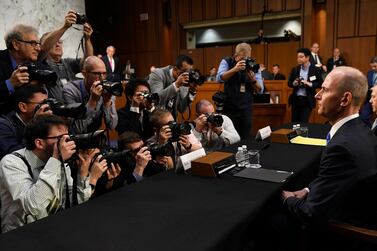Qantas Airways has grounded three of its Boeing 737s over hairline cracks found in wing structures.
The Australian airline expects the planes to be back in service by the end of the year, it said on Friday.
Qantas has been inspecting its aircraft following calls this month from the US Federal Aviation Administration for all airlines to check Boeing 737 NG aircraft that had completed more than 30,000 take-off and landing cycles for cracking in a part that helps keep wings attached. These are different from the 737 Max jets, which were grounded worldwide earlier this year.
Qantas's domestic and freight chief executive Andrew David said the airline had examined in a week all 33 jets of the fleet of 75 that had completed more than 22,600 cycles in two and a half years of flying.
The hairline crack was found in one of eight bolts in the pickle fork assembly in each of the three planes.
“Minimal risk, we are being very prudent,” Mr David said. “Those three aircraft are on the ground. We will get them back flying by the end of the year.”
Mr David said the airline would “have to make some minor schedule changes” while the aircraft were repaired.
Rival domestic airline Virgin Australia said on Friday it had inspected 19 of its 77 737 jets and found no cracks.
Mr David criticised the Australian Licensed Aircraft Engineers Association, the body representing the workers who carry out the checks, for calling on Thursday for all 75 of Qantas’s 737s to be grounded while they were inspected.
“We’re very, very disappointed. They’ve completely misrepresented the facts,” Mr David said. “If they were genuine about their safety concerns, why not work with the regulators? Why not work with the industry?”
Association secretary Steve Purvinas on Friday maintained his call for all Qantas 737s to be grounded. Mr Purvinas was critical of the airline for flying the third 737 for an additional day before the crack was discovered.
“They will not check these planes because they know very well if they find another cracked aircraft, it will be out of service until the end of the year as well, and that will cost them money,” Mr Purvinas told Australian Broadcasting Corporation.
Qantas said it was working with Civil Aviation Safety Authority, the Australian aviation industry regulator, and Boeing to resolve this issue, which involved complex repair work.
There are about 6,800 next-generation 737 jets in service around the world, including lower-mileage aircraft that don’t fall under the FAA’s directive. Globally, about 5 per cent of aircraft that required urgent checks had cracks, Boeing said last month.
The US manufacturer has already been under heavy scrutiny after 737 Max planes crashed in Indonesia and Ethiopia, killing 346 people. US congressional hearings this week have produced internal Boeing documents showing that company employees raised concerns about the design of a key flight-control system and the hectic pace of aircraft production long before the crashes took place.







